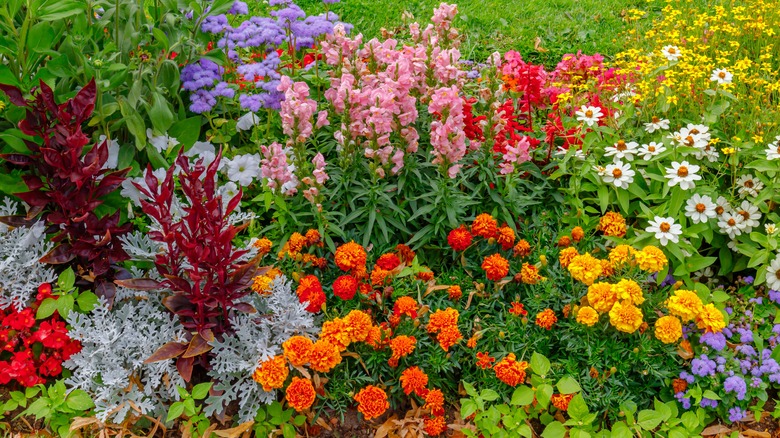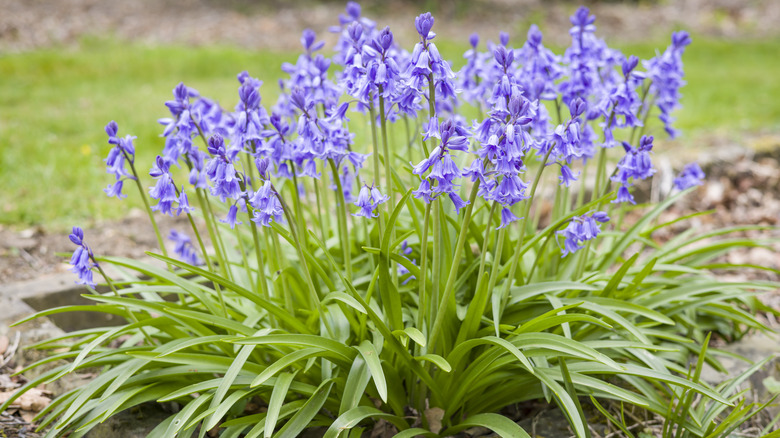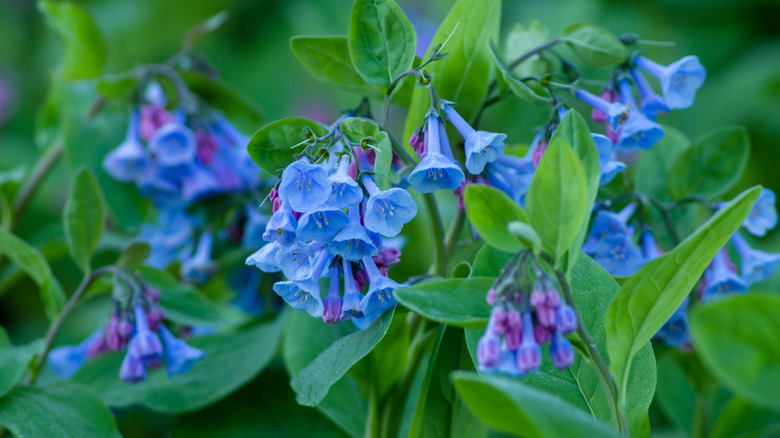The Gorgeous Flower You'll Wish You Never Planted In Your Garden
In a movie about flowers, Spanish bluebells would play the villains. Just when you're convinced they've been conquered, the plants burst from underground hideouts seemingly stronger and more numerous than before. You may be charmed by their beautiful bell-shaped flowers, but their aggressive growing habits and uncanny regenerative abilities can make these dreamy plants a recurring nightmare.
Native to Spain, Portugal, and North Africa, Spanish bluebells (Hyacinthoides hispanica) are bulbous perennial herbs with glossy, blade-like leaves. In mid to late spring, they produce tall flower stalks adorned with violet-blue, bell-shaped flowers. A member of the asparagus family (Asparagaceae), these hardy plants grow in a variety of soils and tolerate shade, making them a good option for planting under trees and other locations where many flowers won't grow. Because bluebells are easy to care for, they are a popular addition to flower beds, borders, and rock gardens. However, you might want to think twice before including these pretty but pernicious plants in your garden. They spread quickly and often take over. Even worse, they are extremely difficult to remove.
Why Spanish bluebells might be a bad choice for your garden
Online forums are packed with pleas from desperate gardeners struggling to banish Spanish bluebells from their yards. These prolific plants spread by self-seeding and by producing small immature bulbs called offsets. Thanks to their robust reproductive nature, they are not easily contained by typical methods used to keep invasive plants from spreading. They are also highly resistant to weed killers, so the closest thing to an effective way to get rid of them (which is still rather ineffective) is digging them up. However, the bulbs are often buried deep in the soil and difficult to find. The immature bulbs, which resemble large, white roots, are especially easy to miss. If you don't want to dig up your garden, you can try starving the plants by cutting off the shoots before they flower. But you'll have to repeat this process for each plant every week for the duration of the growing season. Regardless of which method you choose, be prepared for a long battle. It may take several years to snuff out these sinister plants. If you miss even one bulb or seed, they'll be back.
As if their relentless refusal to die isn't dreadful enough, Spanish bluebells are also toxic to people and pets. All parts of the plant contain scillaren, a cardiac glycoside that causes irregular heart rates, diarrhea, vomiting, abdominal pain, and trembling. The sticky sap from bluebells also irritates skin, so always wear gloves when handling them.
What to plant in place of Spanish bluebells
There are many stunning blue flowers you can grow in your garden, including several native plants. The most obvious alternative to the Spanish bluebell is the Virginia bluebell (Mertensia virginica), a wildflower native to much of the central and eastern U.S. These nontoxic herbaceous perennials have oval-shaped, greenish-gray leaves and produce blue, trumpet-shaped flowers in mid spring. They are shade-tolerant and work well in borders and beds. Virginia bluebells grow from seeds as well as modified underground stems, called rhizomes, that send out shoots and leaves. While they don't grow as aggressively as Spanish bluebells, they do form clumps and may spread out into other areas of the garden.
The common camas (Camassia quamash) is another great alternative to Spanish bluebells. A member of the lily family (Liliaceae), these bulbous perennials are native to much of the western parts of Canada and the U.S. These nontoxic plants have narrow, grass-like leaves and grow about 2 to 3 feet high. They bloom in late spring or early summer, producing a tall flower stalk topped by dozens of star-shaped, blue-violet flowers. Camas are easy to grow and prefer sun or part shade. Like bluebells, they tend to grow in clumps and work well in beds and borders.
You can find additional flower species that grow well in your region using the Native Plants Database. If you're currently engaged in a battle with Spanish bluebells, hang in there. In the movies, the good guys (almost) always win.


